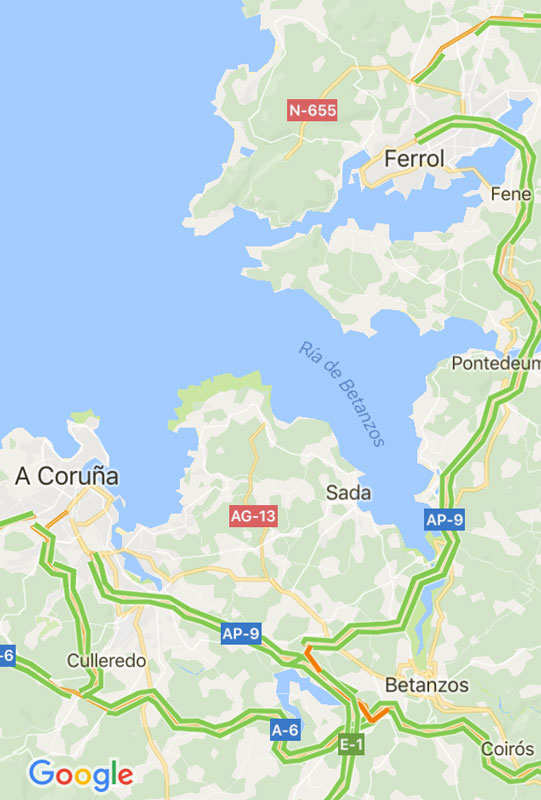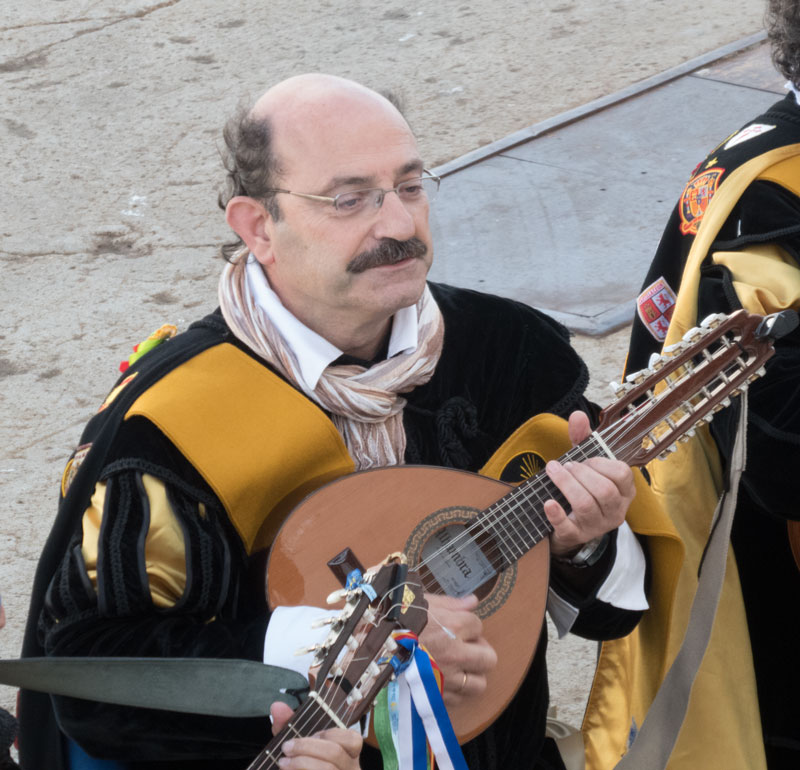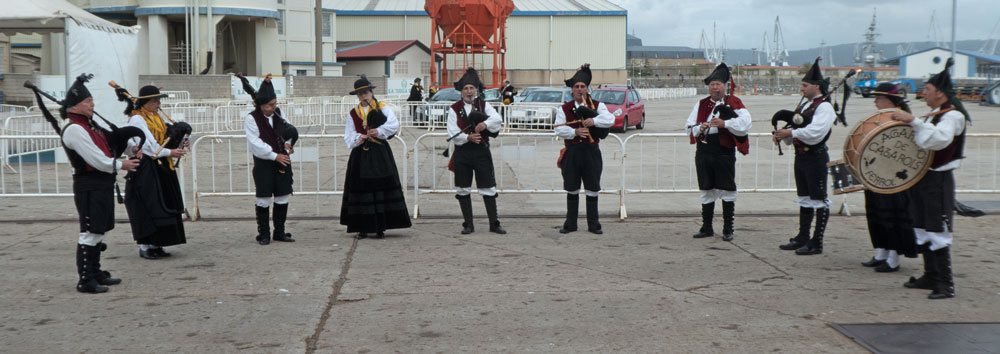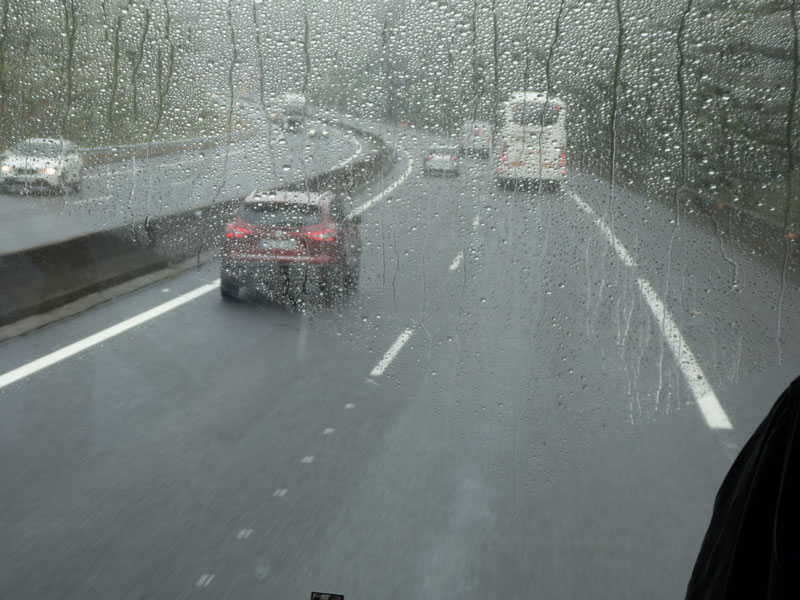
Trip to France, Spain and Portugal
Mike and Judy Henderson
September 1 to September 25, 2017
I'm going to leave the map on each page describing this trip so you have an idea of where we are.

9/12/2017 We arrived in Ferrol this morning after another rough night. Not as bad as last night but still lots of pitching. Our tour was actually of A Coruña even though we came in at Ferrol. The town is listed on the map and on street signs as "A Coruña" but I also saw it as "La Coruña".

Perhaps Ferrol was more hospitable to cruise ships than A Coruña. A Coruña has a port and the tour was of A Coruña so there was some reason we docked in Ferrol and bused to A Coruña. I assume the port fees at Ferrol are a lot less than at A Coruña.
Ferrol certainly went all out to make us welcome. They provided a bus that ran from the dock to town on a regular basis (about every 20 minutes) and they came out to wish us goodbye when we were ready to leave - but more on that later.
A 45 minute bus ride to A Coruña gave us an opportunity to see some of the countryside. In A Coruña our first stop was at the Tower of Hercules, a lighthouse. The original lighthouse was built by the Romans but this one was built about the mid-1700's, and was probably restored since that time.

For a fee, you can go to the top, but we chose to only walk the base of the tower. It provides some outstanding views of the coast.

It's a good background for a picture of a pretty woman.

Next, we went to the port area of A Coruña. The buildings shown in the next picture were described as having belonged to wealthy fisherman. Their entrances were on the other side of the building and the wall of windows was to let light and heat in during the winter.

Our guide then took us to the Plaza of Maria Pita in the old city where the Palacio Municipal is located (the link is in Spanish).

Then we were given some free time to walk around the old city and it's small streets. We found a small ice cream shop and had a blended mocha coffee before boarding the bus to return to the ship for lunch.

In the afternoon, Judy and I took the bus into Ferrol to find WiFi access so that I could upload the blog. Ferrol is very accommodating to visitors. In addition to providing the free shuttle bus from the port, they provide free public Internet access in quite a number of locations in the city. Initially, we found a small cafe and used their WiFi because we wanted to sit and have a drink while I uploaded the blog. Later, I did use the free WiFi and it was easy to use (they didn't ask for your name and email) and fast.
In walking around Ferrol, we encountered this statue. It's supposed to represent a pilgrim on the Camino de Santiago but, to us as Americans, it looks a lot like a member of the KKK.


After we went back to the ship, we had a surprise at 6pm - a group of musicians from the town came to serenade us.



They played for nearly a half hour. When they finished, a group of bagpipers marched up and entertained us until we departed. Two of the bagpipers and one of the drummers were women. The bagpipe is a traditional instrument of Galicia.


This man was the leader of the group.

I thought this piper looked interesting. He looked like a Sikh with that beard.

We're sailing to Vigo and will visit Santiago de Compostela, the church which reputedly contains relics of the apostle St. James.
9/12/2017 The voyage from Ferrol was a bit better last night. In the early part of the voyage the ship was pitching as it did the past few nights. But around 2am, we turned south and entered calmer water. The sailing was much smoother. We're all keeping our fingers crossed that the rest of the voyage is smooth.
We arrived in Vigo early in the morning, to a light rain and overcast skies.

Today, we're going to Santiago de Compostela, a famous cathedral which is reputed to hold the remains of the apostle St. James. Actually, Santiago de Compostela is between Ferrol and Vigo so we could have bused to it from either port. From Vigo it's about an hour and a half drive. We departed about 10:30 and arrived about noon.
In addition to being famous for holding the reputed remains of St. James, Santiago de Compostela is the terminus of a pilgrimage. The path of the pilgrimage is known as the Camino de Santiago and there are many routes. Perhaps the most famous is known as the "French Way" and begins in Saint-Jean-Pied-de-Port, perhaps 800km from Santiago de Compostela. Pilgrims carry a scallop shell to show that they are on the pilgrimage and you'll see many scallop shell trinkets at Santiago de Compostela. I'm not sure why people make the pilgrimage but I was told that the Catholic Church grants an indulgence to those who complete the pilgrimage. If you register with the proper organization before you go, you can get a certificate of completion when you finish the pilgrimage. To get the certificate, you have to walk the last 100km, or bike the last 200km.
The story of how the remains of St. James came to Santiago de Compostela varies but one story is that, after being executed in Jerusalem in about 44AD, his remains were brought to Spain. Around the year 815 (or 820), a Spanish hermit named Pelayo had a vision of a bright star shining over a spot in the forest. The remains found in that location were taken to be St. James.
The pilgrimage to Santiago de Compostela apparently became popular because the pilgrimage to Jerusalem or Rome was much more difficult.

It was raining when we left Vigo.

But by the time we arrived in Santiago de Compostela the weather had cleared. We had a few showers during our visit but nothing serious.

We met our guides who took us to the main square. The church is undergoing renovation so there was scaffolding over much of the front.

Since it was about noon, we were dismissed for lunch and the group went to different restaurants. Judy and I wound up at the same restaurant as some of the others in our group, and we had lunch with Tiff and Joanne.

Judy and Tiff had the Galician pie as a starter. It has a pastry shell and is filled with fish and onion in a somewhat sweet sauce. It was actually very tasty.

We reassembled in the square at 2pm for a tour.

Here's a panoramic view of the square.

The tour lasted perhaps an hour and a half, after which we were given free time to wander the town. We were told to reassemble at ten to five for a tour of the church. Judy and I did some wandering but eventually found a place to sit until time for the church tour.
There's a university in the town - the University of Santiago de Compostela - which abbreviates to "USC", which is the same abbreviation of University of Southern California. I include this picture for our friends back home.

We met by the fountain in front of the entrance (which is actually on the side of the church, perhaps because of the renovation).

Note the tower with the clock.

The clock only has one hand. Early clocks only had one hand, perhaps because the technology had not developed to have two hands, and maybe one hand told time "close enough" for that time. After all, those early clocks were not all that accurate.

As we entered the church, we could not see the main alter since we were in the transept.

The guide walked us around the main alter (side and back) and we saw some of the small chapels that were located there. We learned that wealthy families would pay for a chapel and would have private services there.




Many cathedrals have these small chapels built into the sides of the cathedral, but there was another reason for having them. Catholic priests are required to offer a mass daily (I believe) and there were too many priests at a cathedral for them to officiate at a public mass - there just weren't that many public masses held each day. So the priests would individually offer a mass at these chapels, even if no one was attending. If a reader knows more about the Catholic faith and wants to correct me, please do so.
We eventually were able to pass the crypt where the reputed remains of St James were resting, in a silver coffin.

Then we went into the main part of the church were we could see the main alter. Pretty elaborate, isn't it? You can see a few people in the background which helps you appreciate the scale of this alter.

Here are close-ups of two of the angels at the top left and right of the alter.


And that ended our tour of Santiago de Compostela. It was back to the buses for the trip back to Vigo, a late dinner and the departure for Porto.
Our adventure continues here